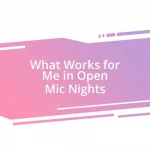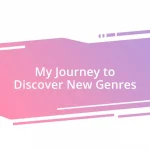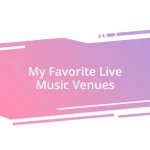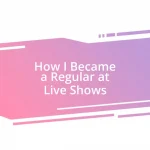Key takeaways:
- Understanding audience expectations and fostering personal connections enhance concert experiences.
- Selecting the right venue impacts ambiance, artist-audience connection, and overall engagement.
- Integrating visual and technological elements creates immersive, memorable performances.
- Gathering and acting on feedback helps improve future concerts and strengthens audience relations.

Understanding audience expectations
Understanding audience expectations is crucial for creating truly memorable concert experiences. When I attend a concert, I often find myself anticipating not just the songs I love, but also the entire atmosphere—how the lighting will complement the music, or whether the artist will engage with the crowd. Have you ever noticed how a simple moment of connection can elevate an event from good to unforgettable?
I remember attending a small venue show where the artist took the time to share stories behind each song. It felt personal and made me feel like a part of their journey. This deep connection shaped my experience; I left feeling as though I had shared something special with the performer. It’s these personal touches that can meet, or even exceed, audience expectations, leaving lasting memories.
Moreover, understanding what the audience craves can fine-tune the overall experience. Are they there for the nostalgia of classic hits or the excitement of new music? By tapping into these nuances, I’ve learned that it’s not just about the music; it’s about curating an emotional experience that resonates long after the last encore. What do you think makes a concert truly unforgettable?

Selecting the right venue
Selecting the right venue is a pivotal aspect of curating memorable concert experiences. I’ve found that the vibe of the venue can completely transform how the music is received. For instance, I once attended a concert in an eclectic old theater, where the acoustics amplified each note. The architecture wasn’t simply a backdrop; it enhanced the music, turning the evening into a sensory masterpiece.
The size of the venue also matters significantly. A small, intimate space can foster a deep connection between the artist and the audience. I remember seeing a local band at a cozy pub where I was just a few feet away from the performers. Each song felt like an exclusive experience, where I could see the passion in their eyes. In contrast, larger arenas can excite with spectacular visuals and production, but sometimes they can dilute that personal connection.
Ultimately, I believe that the ambiance and energy of the venue set the stage—quite literally!—for the entire event. It’s important to consider the types of experiences that audiences are seeking. Are they looking for a communal experience, or something more personal? With thoughtful venue selection, I can create concerts that resonate, making every note unforgettable.
| Factors | Small Venues | Large Venues |
|---|---|---|
| Atmosphere | Intimate and personal | Grand and energetic |
| Connection | Strong artist-audience bond | Broader audience experience |
| Acoustics | Often unique; enhances intimacy | Technological enhancements; variable quality |
| Cost | Typically lower | Higher production costs |
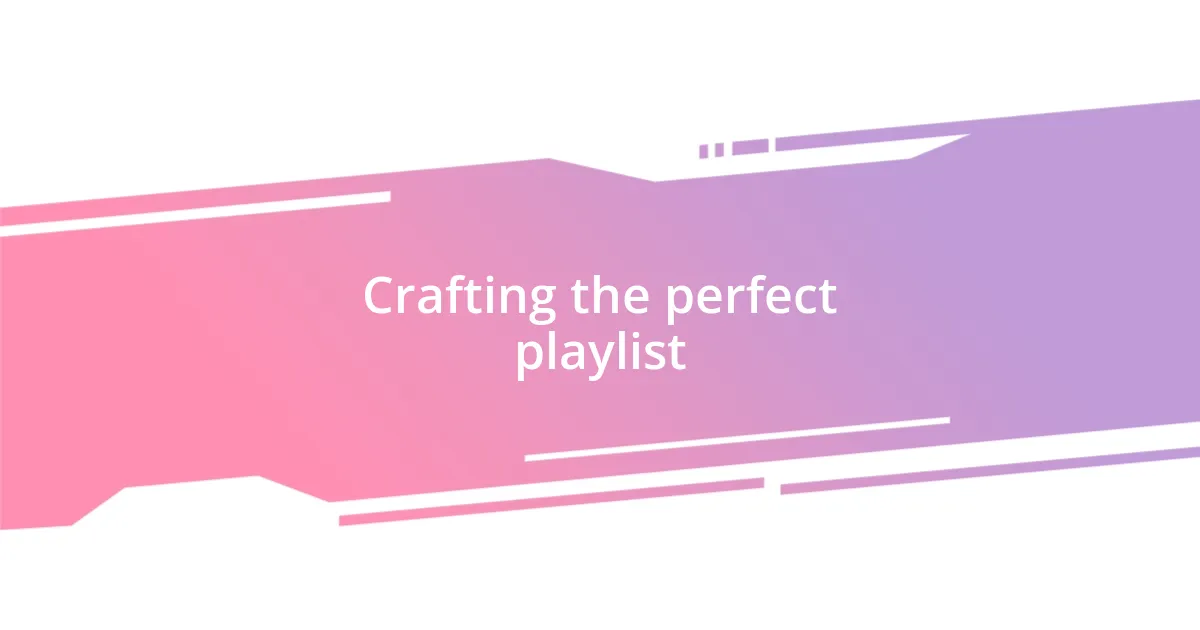
Crafting the perfect playlist
Crafting the perfect playlist is an art that can elevate a concert to new heights. I often think about the emotional journey I want to take the audience on. It’s like telling a story—each song is a chapter, transitioning smoothly into the next. For example, I once attended a concert where the artist started with an upbeat anthem that had everyone dancing, then shifted to a beautiful ballad that brought a collective sigh from the crowd. The contrast created a powerful emotional arc that lingered long after the show.
To create an unforgettable setlist, I consider the following elements:
- Flow: Balance energetic songs with slower ones for emotional impact.
- Audience Engagement: Include crowd favorites and unexpected gems to keep the energy high.
- Themes: Use songs that convey a cohesive message or narrative.
- Surprises: Occasionally throw in a cover or a new track to keep the audience guessing.
- Building Anticipation: End with a bang—close with signature hits that everyone knows and loves.
I’ve discovered that when I curate a playlist that reflects both the artist’s essence and the audience’s desires, the concert becomes an interactive experience, forging a deeper connection that resonates well beyond the last note.

Engaging with the crowd
Engaging with the crowd is where the magic happens during a concert. I’ve noticed that when an artist takes a moment to interact with the audience, it transforms the atmosphere. For instance, I remember a show where the lead singer asked everyone to sing along to their favorite song. The sheer joy on people’s faces as they harmonized together was electric. It created this beautiful moment of connection that made everyone feel like they were a part of something special.
I also find that body language plays a crucial role in crowd engagement. I’ve seen artists who really lean into their movements, capturing the audience’s attention. When they move through the crowd or make eye contact with fans, it feels personal. These little actions—whether it’s a smile or a genuine laugh—can create an unforgettable connection. Don’t you think it’s amazing how a simple gesture can create a shared memory?
Creating an engaging environment involves knowing your audience, too. I once attended a concert where the performer genuinely interacted with fans, sharing stories and asking about their experiences. It felt like being part of a conversation rather than just watching a show. That’s when I realized: it’s not just about the performance; it’s about creating moments that resonate on a personal level, making every attendee feel valued and included. Wouldn’t it be wonderful if every concert could leave you with that kind of warmth?
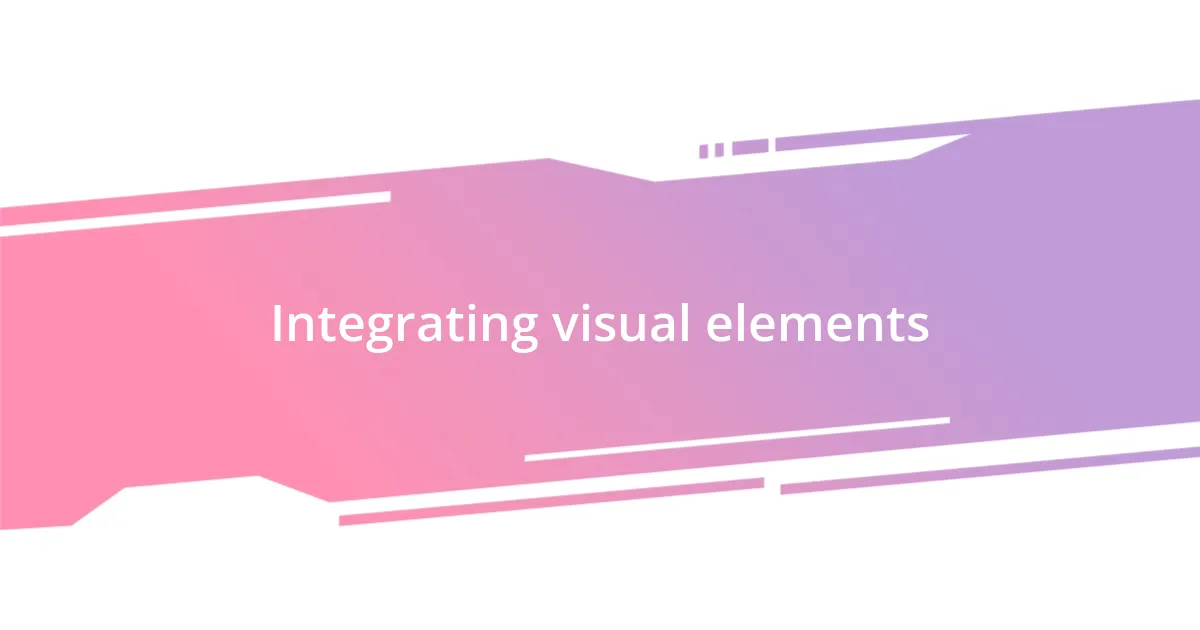
Integrating visual elements
Integrating visual elements into a concert enhances the overall experience and leaves a lasting impression. I remember a show where the backdrop consisted of stunning visuals that matched the music’s rhythm and mood. These immersive images brought the performance to life, making each song more impactful. Can you imagine how a perfectly timed visual transition could elevate a heart-pounding anthem? It truly transforms the energy in the room.
I’ve also noticed that lighting plays an essential role in shaping the audience’s emotions. A well-timed spotlight can elevate a dramatic moment, while colorful strobe lights can energize the crowd during upbeat sections. One concert I attended had an impressive light show that synchronized with the music, and it felt as if we were all part of a vibrant painting. That experience hadn’t just engaged my eyes; it stirred up emotions and connected all of us in real time.
When artists incorporate visual storytelling, it sparks curiosity and enhances engagement. For instance, a performer might create a thematic visual journey that reflects the lyrics’ meaning, like using imagery of nature for a song about growth. I find it fascinating how visuals can stir emotions without uttering a single word. This synergy of sound and sight encourages the audience to interpret the performance personally—making it an unforgettable experience. What could be more captivating than that blend of artistry?

Utilizing technology effectively
Utilizing technology effectively is key to crafting memorable concert experiences. I recall attending a performance where the artist used augmented reality (AR) to bring elements of the stage to life. As visuals danced around the venue, it felt like stepping into a different world, bridging the gap between the audience and the stage. Have you ever experienced that blend of reality and imagination through AR? It truly makes the event feel unique and immersive.
Another powerful tool in a modern concert is the use of mobile apps to enhance fan interaction. At one show, I downloaded the event’s app, which allowed me to participate in live polls and request songs in real-time. Suddenly, I wasn’t just a spectator—I was part of the performance! I can’t help but wonder, how does it feel to transform from an observer to an active participant in such a dynamic environment?
Additionally, high-quality sound technology elevates the concert experience like nothing else. I attended a concert where the audio equipment was top-notch, allowing each note to resonate perfectly. The crispness of the live music made me feel every beat in my bones, creating a connection I’ll never forget. Can you imagine hearing every subtle element of a song without distortion? The right sound system can make a significant difference, transforming a good show into an unforgettable auditory journey.

Gathering feedback for improvement
Gathering feedback is essential for continuous improvement in any concert experience. After every event, I make it a point to connect with attendees, whether through social media or direct conversations. I often ask simple yet insightful questions like, “What was your favorite moment?” or “How did the visuals enhance the performance for you?” These dialogues not only reveal the highlights but also shine a light on areas needing enhancement. Have you ever shared your thoughts after a concert? It’s amazing how those insights can shape future performances.
I also use post-event surveys to gather more structured feedback. I remember sending out a quick questionnaire after a show where we tried new staging ideas. The responses were overwhelmingly positive, yet several attendees pointed out how better crowd control could enhance safety. That kind of feedback is invaluable! It helps tweak our future events, ensuring everyone feels comfortable and engaged. It’s fascinating how a few simple questions can unlock a treasure trove of ideas.
Listening to feedback doesn’t just help in logistics; it deepens my connection with the audience. I recall an occasion when an attendee suggested adding more interactive elements during a set. The next time, I integrated a short Q&A where fans could ask the artist questions live. The energy in the room was electric! Have you ever felt the buzz of a crowd when everyone is genuinely connected? That’s the magic of truly listening and adapting based on what your audience has to say.
